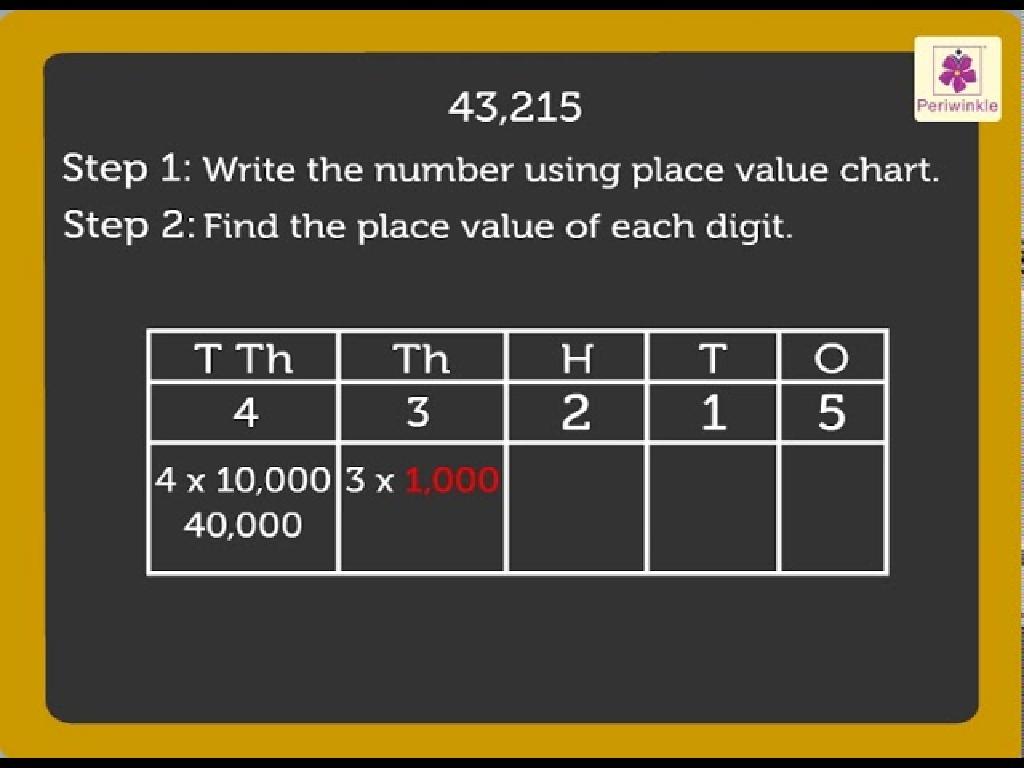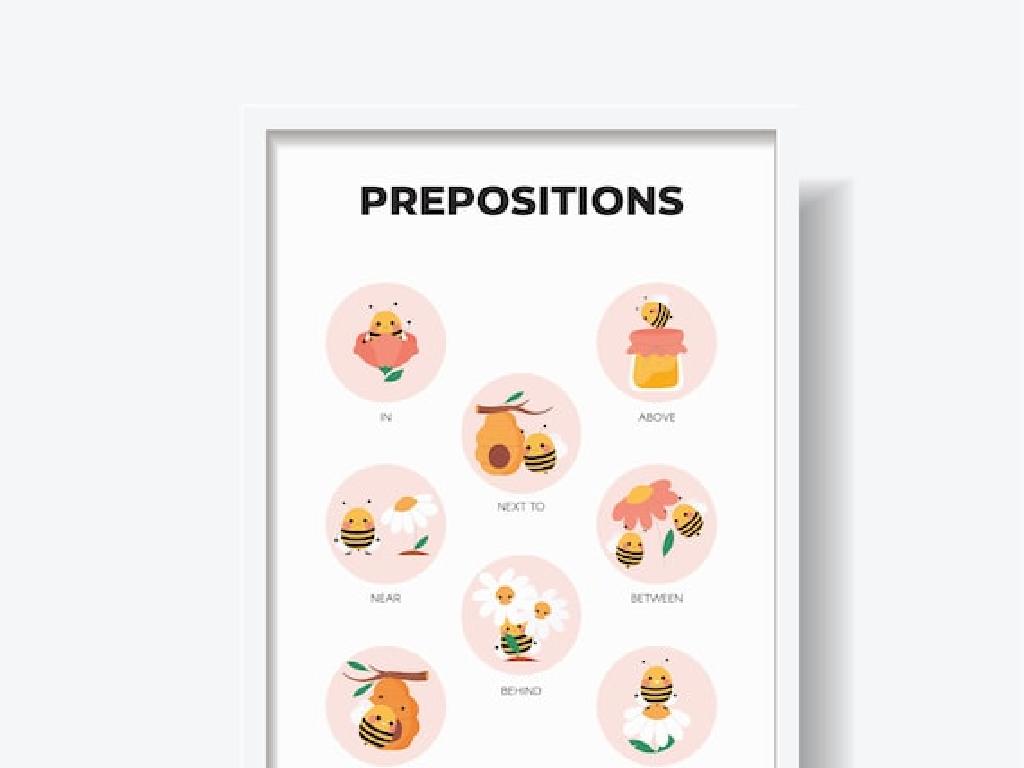Comparison Word Problems Up To 10: What Is The Larger Amount?
Subject: Math
Grade: First grade
Topic: Comparison Word Problems Up To 10
Please LOG IN to download the presentation. Access is available to registered users only.
View More Content
Comparing Numbers: Bigger and Smaller
– Play with numbers up to 10
– Learn to compare two numbers
– Which number is more: 3 or 7?
– Discover what ‘bigger’ means
– Bigger means more than another amount
– Explore what ‘smaller’ means
– Smaller means less than another amount
|
This slide introduces first graders to the concept of comparing numbers. Start by engaging them with the idea that numbers can be fun to play with. Explain that comparing numbers is like looking at two different amounts and deciding which one is more and which one is less. Use simple, relatable examples such as comparing apples or toys to illustrate the concept of ‘bigger’ and ‘smaller’. Encourage the students to use their fingers to count up to 10 and to participate in activities where they can practice comparing numbers with their classmates. The goal is to ensure they understand that ‘bigger’ refers to a larger amount and ‘smaller’ refers to a lesser amount, using numbers they are familiar with.
Let’s Compare Numbers!
– Understanding ‘compare’
– To compare is to see if one number is bigger, smaller, or the same as another.
– Using comparison words
– Words like ‘more’, ‘less’, and ‘equal’ help us describe comparisons.
– Practice with examples
– Example: 5 apples and 8 apples which is more?
– Discovering larger amounts
– We’ll find out which number is bigger in different fun scenarios.
|
This slide introduces the concept of comparison in mathematics to first graders. Start by explaining that comparing is just like looking at two different things to see what’s different about them. Use everyday language and examples, such as comparing the number of cookies on two plates to see which has more. Encourage the students to use the words ‘more’, ‘less’, and ‘equal’ to describe their observations. Provide simple, relatable examples to practice in class, such as comparing sets of toys, fruits, or books. The goal is to make them comfortable with identifying which number is larger in a given pair. This foundational skill will help them with more complex math problems in the future.
Comparing Apples to Apples
– Two baskets with apples
– Basket one has 3 apples
– Basket two has 5 apples
– Which has more? Which has fewer?
– Compare numbers to find which is larger and which is smaller
|
This slide introduces students to comparison word problems using a relatable concept of apples in baskets. The goal is to help them visualize the problem and use counting as a method to compare quantities. Encourage the students to count the apples in each basket and determine which basket has more and which has fewer. This exercise will reinforce their understanding of comparing numbers up to 10. For the activity, you can have real baskets with apples or use manipulatives to represent the apples. Other possible activities include using different fruits or objects, role-playing with students as ‘baskets’ to group and compare, or drawing pictures to visualize the comparisons.
Using Numbers to Compare
– Use a number line for comparison
– Numbers right are bigger
– Place 3 and 5 on the number line
– Find 3 and 5 on the line, see their positions
– Determine which is larger
– See that 5 is to the right of 3, so it’s larger
|
This slide introduces first graders to the concept of using a number line as a visual aid to compare numbers. Emphasize that on a number line, numbers increase in value as you move to the right. Show them how to locate numbers 3 and 5 on the number line and use their positions to determine which number is larger. Reinforce that the number further to the right on the number line is always the bigger number. This will help students understand the concept of comparison and prepare them for solving word problems that involve comparing quantities.
Comparing Numbers: Word Problems
– Word problems are number stories
– Find the larger amount
– Which number is bigger, 5 apples or 8 apples?
– Read a story and discover together
– ‘Tom has 3 balloons, and Jen has 7. Who has more?’
– Practice with examples
|
This slide introduces first graders to the concept of comparison within word problems. Start by explaining that word problems tell a story using numbers, and our task is to find out which number is larger. Emphasize that comparing numbers is like looking for the bigger piece of cake. Read a story problem aloud to the class and solve it together, asking guiding questions to involve the students. For example, ‘Tom has 3 balloons, and Jen has 7. Who has more balloons?’ Encourage the students to visualize or use objects to compare quantities. Conclude with practice examples, ensuring each student understands how to identify the larger amount in a story.
Let’s Solve a Problem: Comparing Quantities
– Count Tom’s toy cars
– Tom has 4 cars
– Count Sally’s toy cars
– Sally has 7 cars
– Who has more toy cars?
– Compare to find who has more
– How many more cars does Sally have?
– Subtract Tom’s amount from Sally’s
|
This slide is designed to help first graders practice comparison word problems by using a relatable scenario involving toy cars. Start by having the students count the number of toy cars Tom has, which is 4. Then, count Sally’s toy cars, which is 7. Ask the class to determine who has more toy cars by comparing the two amounts. Finally, guide them to find out how many more cars Sally has than Tom by subtracting 4 from 7. This exercise not only teaches comparison but also introduces basic subtraction. Encourage the students to visualize the problem with actual toy cars or drawings to enhance understanding.
Class Activity: Comparing Number Pairs
– Pair up and pick number cards
– Compare to find the larger number
– Say which number is more or less
– Use phrases like ‘6 is more than 4’ or ‘3 is less than 5’
– Take turns with your friend
|
This activity is designed to help first graders understand the concept of comparison and the terms ‘more than’ and ‘less than’ in a fun and interactive way. Each student will pair up with a classmate and take turns drawing number cards from a deck containing numbers up to 10. They will then compare their numbers to determine who has the larger amount. Encourage them to articulate the comparison by using phrases like ‘My number is more than your number’ or ‘My number is less than your number’. This verbal reinforcement will help solidify their understanding of comparison. Possible variations of the activity could include using objects instead of number cards, such as blocks or counters, to visually represent the amounts being compared.
Great Comparing Today!
– Celebrate your comparison skills
– Understanding number sizes
– Comparing numbers shows which is bigger or smaller
– Keep practicing at home
– Try comparing toys, snacks, or books
– Comparison is key in math
|
This slide is meant to wrap up the lesson on comparison word problems up to 10. It’s important to praise the students for their effort and to reinforce the concept that comparing numbers helps us understand their size relative to each other. Encourage them to continue practicing at home by comparing everyday items, which will help solidify their understanding of the concept. Remind them that practice is essential to becoming confident in comparing numbers, and that this skill is a fundamental part of mathematics that they will continue to use throughout their education.






